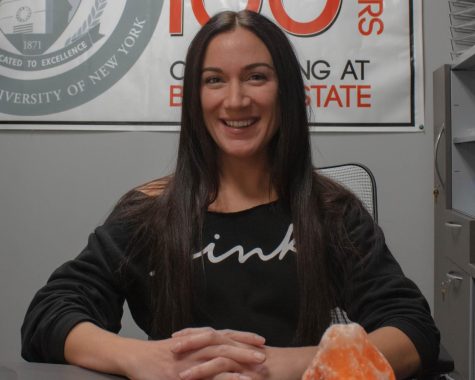Through the Eyes of your Uber Driver
September 28, 2020
Ride sharing apps are essential services for most students housed on the Buffalo State Campus, from getting groceries to attending off-campus recreational activities. To some, its simply a way to get safely to and from a destination. Others may expect a level of service from the driver that goes above and beyond. When you get into an Uber, the experience for you may be black and white. For the driver, it’s always grey.
Have you ever been curious about ride sharing etiquette, expectations, or what the experience is like for the driver?
Conversation.
As the driver, I never know what type of personality will be getting into my backseat. Will it be an introvert that dreads the idea of conversation with a total stranger, or someone more outgoing who can’t stand the thought of a 20 minute drive in silence?
As a rule of thumb, I will always say “hello”, “thank you”, and “have a good day!”, but I typically don’t initiate a dialogue without a verbal cue from the rider.
I asked Monisha, a Buffalo State student and a Thursday night passenger of mine, what is one thing she would like Uber drivers to know?
“I’d want them to know not to talk too much,” said Monisha. “Talking is okay, but some drivers will tell you their whole life story when you didn’t even say anything to them.”
If you’re not into small talk or if you’re just having a bad day, one way to prevent the driver from trying to engage with you is to put in headphones upon entering the vehicle. Another action you can take is being on your phone with someone, or consistently looking down at it for the entirety of the ride.
The most common verbal cues I receive that tell me I have a talkative passenger are “How are you today?”, or “Is it busy for you today?”, or some sort of rhetorical comment about the weather. Either way, your preference is fine with me!
Making the driver wait.
Has your driver ever arrived earlier than expected, or you forgot something right before they pulled up and were hurriedly trying to get outside within your 5 minute window? Have you gotten stuck behind a lady at the checkout with 100 coupons?
You can simply send a quick chat message to let them know you’ll be right out to alleviate both the anxiousness of the driver (who is sitting outside glancing repeatedly at your location waiting for you) and the frustration you feel while rushing.
The Uber app allows the driver to cancel the ride after a 5 minute waiting period, and then charges the rider a cancellation fee. If I receive a chat from the passenger, I will personally not cancel it simply because they had the courtesy to let me know what’s going on and that they are aware I am there.
The ratings system.
My roommate complained that his Uber passenger score is a 4.85, even though he considers himself a novel rider. He is always polite and follows the rules as best he can (be ready at the door when the driver arrives, wear your seatbelt … etc).
I’ve been a driver for three years and have never given a passenger less than five stars. I don’t know if I ever would, unless there were extenuating circumstances. I know how it feels to wonder why your score went down.
On rare occasions I will receive 4 stars too. Admittedly this upsets me as I try my best to not do anything on the ride to deserve less than 5. It drags down my rating, and leaves me wondering what I did wrong.
For me, Uber is my only source of income, it is a full-time job that I cannot afford to lose. If my rating falls below a certain number, or a false report is made against me, I risk being kicked off the platform altogether.
Keep in mind that you are affecting someone’s livelihood.
Usually the issue you are having (temperature, music, conversation) can be rectified by simply speaking up – express this to your driver and they will fix the issue. So, unless they are breaking traffic laws (running stop signs), putting you at risk (almost getting into accidents), or harassing you/ making you uncomfortable, the score you give should be understanding.
Unfortunately, the truth is that you never know exactly what is going on in the minds of different personalities, both driver and passenger.
Going above and beyond.
Covid-19 might hinder a driver from doing things they normally would do. If it isn’t too warm outside, they may choose to crack the windows instead of using the AC based on Uber’s ‘Covid-19 suggestions’ list. If this is bothersome to you, don’t be afraid to let the driver know.
Many students have to carry several bags from the car to the entrance of the dorm – a task I usually never hesitate to help with – but lately I have been asking first if they would like me to help, since I am unsure whether or not they are comfortable with me touching their things.
Other drivers may have given up doing this altogether due to the virus – don’t hold it against them. Some may be uncomfortable with additional interaction because they may have a high-risk family member at home, or just want to be as cautious as possible.
Don’t be afraid to ask for a hand either – I appreciate your business and am happy to help in any way I can!
Changing your trip or adding extra stops.
Some passengers ask me to stop at a gas station or convenient store that is on the way to the destination. I don’t have an issue with this, but some drivers might.
To avoid this, Uber has a way for you to “add a stop” via the app. You can simply add the gas station stop into the trip.
Another change you might want to make is the route the driver is taking. Again, I do not mind this, especially if you know your neighborhood better than I do. However, the direction the driver is going is based on Uber’s GPS, which is supposed to be the quickest route.
Some drivers may be uncomfortable veering from this. They aren’t trying to make your ride longer, they just want to follow Uber’s directions as accurately as possible to avoid any discrepancies.
Ride sharing has only been in Buffalo for a few years but has become one of the most commonly used services– especially among college students. Drivers and riders alike are still getting accustomed to this previously taboo idea. Slowly, they’re finding what makes it enjoyable for them.
“I think it’s unfair,” continued Monisha. “because the driver has to worry about the passenger being as comfortable as possible, but the rider should also be thinking about making the driver’s ride as comfortable as possible too.”
Ultimately, it mainly comes down to communication. Using common sense, human decency, assertiveness and politeness go a long way.






Rachel L. Johnson • Oct 22, 2020 at 3:26 pm
Uber article written with points that made me understand the problem with Uber rating system and I hope Uber looks more into the usage of the rating system.
It would be interesting to know if insurance goes up on cars and I am curious about the perks and disadvantages of working at UBER vs Lift.
Patrick Andrzejak • Sep 29, 2020 at 11:14 am
I definitely think Uber should allow the passenger to see a comment as to why they received an unfair rating. In my case I was a 5 until I was asked for my phone number in an awkward exchange with a driver and my score went down the next day.. I was using Uber about 4x per day at that point so there wouldn’t be any way for me to know whether to complain about the situation as I wouldn’t want to take food off of someone’s table simply because they tried to flirt. I also think this could open up a dialogue about the rating system being used in the wrong way.
Larry Rose • Sep 28, 2020 at 9:34 pm
A well written article that harkens back to a a excellent reminder of civility, and a composite write up of communication. Thank you for a glance into the driver’s rearview so to speak. Well done.
Tracy Thiel • Sep 28, 2020 at 9:01 pm
Great job!!
Jeanine • Sep 28, 2020 at 8:55 pm
Love the article . Had a lot of good points 🙂
Justin M. • Sep 28, 2020 at 8:47 pm
This was actually a enjoyable read and quite insightful as I, too, am a user of the app to travel to and from. Nicely written and laid out.